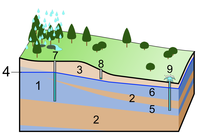
Photo from wikipedia
For the stable securing of water resources for farming and residential purposes, the embankment, preventing the tidal action and intrusion of seawater into the river, have been constructed in the… Click to show full abstract
For the stable securing of water resources for farming and residential purposes, the embankment, preventing the tidal action and intrusion of seawater into the river, have been constructed in the mouth of many major rivers in Korea. The Seomjin River is one of the major rivers without embankment in their mouth and had been famous for the biodiversity and overall environmental health. However, the brackish water zone in the Seomjin River has been gradually extending upstream due to the factors such as extracting aggregate and dredging in the channel, reclamation of the river mouth, and the depletion of runoff discharge from watershed. The saltwater intrusion extended upstream has resulted in the problems such as abrupt changes in ecosystems and environmental conditions over the brackish water areas. In this study, the extent of salinity intrusion has been estimated with Environmental Fluid Dynamics Code (EFDC) model for the total reach of the Seomjin River with the length of 78 km (from Gurye Gauging Station to Yeosu Tide Station, including the endpoint of the Seomjin River). The antecedent rainfall events has been applied to the established model for calibration and verification of the model. In order to consider the effect of the dam construction and resulting changes in runoff characteristics of watershed, the flow duration analyses have been conducted for the cases of before and after the construction of Juam Dam. The results show that the construction of dam and conveying water over the basins result in the depletion of the streamflow, and the depletion of discharge from watershed extend the range of salinity intrusion about 1 km upstream.
Journal Title: KSCE Journal of Civil Engineering
Year Published: 2019
Link to full text (if available)
Share on Social Media: Sign Up to like & get
recommendations!